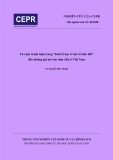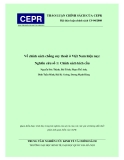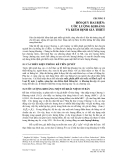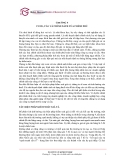
Chapter 5
Elasticity and Its Application
TRUE/FALSE
1. Elasticity measures how responsive quantity is to changes in price.
ANS: T DIF: 1 REF: 5-0 NAT: Analytic
LOC: Elasticity TOP: Price elasticity of demand MSC: Definitional
2. Measures of elasticity enhance our ability to study the magnitudes of changes.
ANS: T DIF: 1 REF: 5-0 NAT: Analytic
LOC: Elasticity TOP: Price elasticity of demand MSC: Definitional
3. The demand for bread is likely to be more elastic than the demand for solid-gold bread plates.
ANS: F DIF: 2 REF: 5-1 NAT: Analytic
LOC: Elasticity TOP: Price elasticity of demand MSC: Interpretive
4. In general, demand curves for necessities tend to be price elastic.
ANS: F DIF: 1 REF: 5-1 NAT: Analytic
LOC: Elasticity TOP: Price elasticity of demand MSC: Interpretive
5. In general, demand curves for luxuries tend to be price elastic.
ANS: T DIF: 1 REF: 5-1 NAT: Analytic
LOC: Elasticity TOP: Price elasticity of demand MSC: Interpretive
6. Necessities tend to have inelastic demands, whereas luxuries have elastic demands.
ANS: T DIF: 2 REF: 5-1 NAT: Analytic
LOC: Elasticity TOP: Price elasticity of demand MSC: Interpretive
7. Goods with close substitutes tend to have more elastic demands than do goods without close substitutes.
ANS: T DIF: 2 REF: 5-1 NAT: Analytic
LOC: Elasticity TOP: Price elasticity of demand MSC: Interpretive
8. The demand for Rice Krispies is more elastic than the demand for cereal in general.
ANS: T DIF: 2 REF: 5-1 NAT: Analytic
LOC: Elasticity TOP: Price elasticity of demand MSC: Interpretive
9. The demand for soap is more elastic than the demand for Dove soap.
ANS: F DIF: 2 REF: 5-1 NAT: Analytic
LOC: Elasticity TOP: Price elasticity of demand MSC: Interpretive
10. The demand for gasoline will respond more to a change in price over a period of five weeks than over a period
of five years.
ANS: F DIF: 2 REF: 5-1 NAT: Analytic
LOC: Elasticity TOP: Price elasticity of demand MSC: Interpretive
11. Even the demand for a necessity such as gasoline will respond to a change in price, especially over a longer
time horizon.
ANS: T DIF: 2 REF: 5-1 NAT: Analytic
LOC: Elasticity TOP: Price elasticity of demand MSC: Interpretive
12. The price elasticity of demand is defined as the percentage change in quantity demanded divided by the
percentage change in price.
ANS: T DIF: 1 REF: 5-1 NAT: Analytic
LOC: Elasticity TOP: Price elasticity of demand MSC: Definitional
32

33 Chapter 5 /Elasticity and Its Application
13. The price elasticity of demand is defined as the percentage change in price divided by the percentage change
in quantity demanded.
ANS: F DIF: 1 REF: 5-1 NAT: Analytic
LOC: Elasticity TOP: Price elasticity of demand MSC: Definitional
14. Suppose that when the price rises by 20% for a particular good, the quantity demanded of that good falls by
10%. The price elasticity of demand for this good is equal to 2.0.
ANS: F DIF: 2 REF: 5-1 NAT: Analytic
LOC: Elasticity TOP: Price elasticity of demand MSC: Analytical
15. Suppose that when the price rises by 10% for a particular good, the quantity demanded of that good falls by
20%. The price elasticity of demand for this good is equal to 2.0.
ANS: T DIF: 2 REF: 5-1 NAT: Analytic
LOC: Elasticity TOP: Price elasticity of demand MSC: Analytical
16. If the price of calculators increases by 15 percent and the quantity demanded per week falls by 45 percent as a
result, then the price elasticity of demand is 3.
ANS: T DIF: 2 REF: 5-1 NAT: Analytic
LOC: Elasticity TOP: Price elasticity of demand MSC: Applicative
17. Demand is inelastic if the price elasticity of demand is greater than 1.
ANS: F DIF: 1 REF: 5-1 NAT: Analytic
LOC: Elasticity TOP: Inelastic demand MSC: Definitional
18. A linear, downward-sloping demand curve has a constant elasticity but a changing slope.
ANS: F DIF: 2 REF: 5-1 NAT: Analytic
LOC: Elasticity TOP: Price elasticity of demand MSC: Interpretive
19. Price elasticity of demand along a linear, downward-sloping demand curve increases as price falls.
ANS: F DIF: 3 REF: 5-1 NAT: Analytic
LOC: Elasticity TOP: Price elasticity of demand MSC: Interpretive
20. If the price elasticity of demand is equal to 0, then demand is unit elastic.
ANS: F DIF: 1 REF: 5-1 NAT: Analytic
LOC: Elasticity TOP: Price elasticity of demand MSC: Definitional
21. If the price elasticity of demand is equal to 1, then demand is unit elastic.
ANS: T DIF: 1 REF: 5-1 NAT: Analytic
LOC: Elasticity TOP: Price elasticity of demand MSC: Definitional
22. Demand for a good is said to be inelastic if the quantity demanded increases substantially when the price falls
by a small amount.
ANS: F DIF: 1 REF: 5-1 NAT: Analytic
LOC: Elasticity TOP: Inelastic demand MSC: Definitional
23. The midpoint method is used to calculate elasticity between two points because it gives the same answer
regardless of the direction of the change.
ANS: T DIF: 2 REF: 5-1 NAT: Analytic
LOC: Elasticity TOP: Midpoint method MSC: Interpretive
24. The flatter the demand curve that passes through a given point, the more inelastic the demand.
ANS: F DIF: 2 REF: 5-1 NAT: Analytic
LOC: Elasticity TOP: Price elasticity of demand MSC: Interpretive
25. The flatter the demand curve that passes through a given point, the more elastic the demand.
ANS: T DIF: 2 REF: 5-1 NAT: Analytic
LOC: Elasticity TOP: Price elasticity of demand MSC: Interpretive

Chapter 5 /Elasticity and Its Application 34
26. If demand is perfectly inelastic, the demand curve is vertical, and the price elasticity of demand equals 0.
ANS: T DIF: 2 REF: 5-1 NAT: Analytic
LOC: Elasticity TOP: Perfectly inelastic demand MSC: Interpretive
27. If demand is perfectly elastic, the demand curve is horizontal, and the price elasticity of demand equals 1.
ANS: F DIF: 2 REF: 5-1 NAT: Analytic
LOC: Elasticity TOP: Perfectly elastic demand MSC: Interpretive
28. Along the elastic portion of a linear demand curve, total revenue rises as price rises.
ANS: F DIF: 3 REF: 5-1 NAT: Analytic
LOC: Elasticity TOP: Total revenue | Price elasticity of demand
MSC: Interpretive
29. If a firm is facing elastic demand, then the firm should decrease price to increase revenue.
ANS: T DIF: 2 REF: 5-1 NAT: Analytic
LOC: Elasticity TOP: Total revenue | Price elasticity of demand
MSC: Applicative
30. If a firm is facing inelastic demand, then the firm should decrease price to increase revenue.
ANS: F DIF: 2 REF: 5-1 NAT: Analytic
LOC: Elasticity TOP: Total revenue | Price elasticity of demand
MSC: Applicative
31. When demand is inelastic, a decrease in price increases total revenue.
ANS: F DIF: 2 REF: 5-1 NAT: Analytic
LOC: Elasticity TOP: Inelastic demand | Total revenue MSC: Interpretive
32. The income elasticity of demand is defined as the percentage change in quantity demanded divided by the
percentage change in income.
ANS: T DIF: 1 REF: 5-1 NAT: Analytic
LOC: Elasticity TOP: Income elasticity of demand MSC: Definitional
33. The income elasticity of demand is defined as the percentage change in quantity demanded divided by the
percentage change in price.
ANS: F DIF: 1 REF: 5-1 NAT: Analytic
LOC: Elasticity TOP: Income elasticity of demand MSC: Definitional
34. Normal goods have negative income elasticities of demand, while inferior goods have positive income
elasticities of demand.
ANS: F DIF: 2 REF: 5-1 NAT: Analytic
LOC: Elasticity TOP: Income elasticity of demand MSC: Interpretive
35. If the income elasticity of demand for a good is negative, then the good must be an inferior good.
ANS: T DIF: 1 REF: 5-1 NAT: Analytic
LOC: Elasticity TOP: Income elasticity of demand MSC: Interpretive
36. If the cross-price elasticity of demand for two goods is negative, then the two goods are substitutes.
ANS: F DIF: 2 REF: 5-1 NAT: Analytic
LOC: Elasticity TOP: Cross-price elasticity of demand MSC: Interpretive
37. If the cross-price elasticity of demand for two goods is negative, then the two goods are complements.
ANS: T DIF: 2 REF: 5-1 NAT: Analytic
LOC: Elasticity TOP: Cross-price elasticity of demand MSC: Interpretive
38. Cross-price elasticity of demand measures how the quantity demanded of one good changes as the price of
another good changes.
ANS: T DIF: 1 REF: 5-1 NAT: Analytic
LOC: Elasticity TOP: Cross-price elasticity of demand MSC: Definitional

35 Chapter 5 /Elasticity and Its Application
39. Cross-price elasticity is used to determine whether goods are inferior or normal goods.
ANS: F DIF: 2 REF: 5-1 NAT: Analytic
LOC: Elasticity TOP: Cross-price elasticity of demand MSC: Interpretive
40. Cross-price elasticity is used to determine whether goods are substitutes or complements.
ANS: T DIF: 2 REF: 5-1 NAT: Analytic
LOC: Elasticity TOP: Cross-price elasticity of demand MSC: Interpretive
41. The cross-price elasticity of garlic salt and onion salt is -2, which indicates that garlic salt and onion salt are
substitutes.
ANS: F DIF: 2 REF: 5-1 NAT: Analytic
LOC: Elasticity TOP: Cross-price elasticity of demand MSC: Interpretive
42. Price elasticity of supply measures how much the quantity supplied responds to changes in the price.
ANS: T DIF: 1 REF: 5-2 NAT: Analytic
LOC: Elasticity TOP: Price elasticity of supply MSC: Definitional
43. Supply and demand both tend to be more elastic in the long run and more inelastic in the short run.
ANS: T DIF: 2 REF: 5-1 | 5-2 NAT: Analytic
LOC: Elasticity TOP: Price elasticities of demand and supply
MSC: Interpretive
44. If the price elasticity of supply is 2 and the quantity supplied decreases by 6%, then the price must have
decreased by 3%.
ANS: T DIF: 2 REF: 5-2 NAT: Analytic
LOC: Elasticity TOP: Price elasticity of supply MSC: Applicative
45. Supply is said to be inelastic if the quantity supplied responds substantially to changes in the price, and elastic
if the quantity supplied responds only slightly to price.
ANS: F DIF: 1 REF: 5-2 NAT: Analytic
LOC: Elasticity TOP: Price elasticity of supply MSC: Definitional
46. Supply tends to be more elastic in the short run and more inelastic in the long run.
ANS: F DIF: 2 REF: 5-2 NAT: Analytic
TOP: Price elasticity of supply MSC: Interpretive
47. When the price of knee braces increased by 25 percent, the Brace Yourself Company increased its quantity
supplied of knee braces per week by 75 percent. BYC's price elasticity of supply of knee braces is 0.33.
ANS: F DIF: 2 REF: 5-2 NAT: Analytic
LOC: Elasticity TOP: Price elasticity of supply MSC: Applicative
48. If a supply curve is horizontal, then supply is said to be perfectly elastic, and the price elasticity of supply
approaches infinity.
ANS: T DIF: 2 REF: 5-2 NAT: Analytic
LOC: Elasticity TOP: Perfectly elastic supply MSC: Interpretive
49. A government program that reduces land under cultivation hurts farmers but helps consumers.
ANS: F DIF: 2 REF: 5-3 NAT: Analytic
LOC: Elasticity TOP: Total revenue MSC: Applicative
50. OPEC failed to maintain a high price of oil in the long run, partly because both the supply of oil and the
demand for oil are more elastic in the long run than in the short run.
ANS: T DIF: 2 REF: 5-3 NAT: Analytic
LOC: Elasticity TOP: OPEC | Price elasticity of demand | Price elasticity of supply
MSC: Applicative

Chapter 5 /Elasticity and Its Application 36
51. Drug interdiction, which reduces the supply of drugs, may decrease drug-related crime because the demand for
drugs is inelastic.
ANS: F DIF: 2 REF: 5-3 NAT: Analytic
LOC: Elasticity TOP: Price elasticity of demand MSC: Applicative
SHORT ANSWER
1. Consider the following pairs of goods. For which of the two goods would you expect the demand to be more
price elastic? Why?
a. water or diamonds
b. insulin or nasal decongestant spray
c. food in general or breakfast cereal
d. gasoline over the course of a week or gasoline over the course of a year
e. personal computers or IBM personal computers
ANS:
a. Diamonds are luxuries, and water is a necessity. Therefore, diamonds have the more elastic demand.
b. Insulin has no close substitutes, but decongestant spray does. Therefore, nasal decongestant spray has the
more elastic demand.
c. Breakfast cereal has more substitutes than does food in general. Therefore, breakfast cereal has the more
elastic demand.
d. The longer the time period, the more elastic demand is. Therefore, gasoline over the course of a year has
the more elastic demand.
e. There are more substitutes for IBM personal computers than there are for personal computers. Therefore,
IBM personal computers have the more elastic demand.
DIF: 2 REF: 5-1 NAT: Analytic LOC: Elasticity
TOP: Price elasticity of demand MSC: Applicative


























